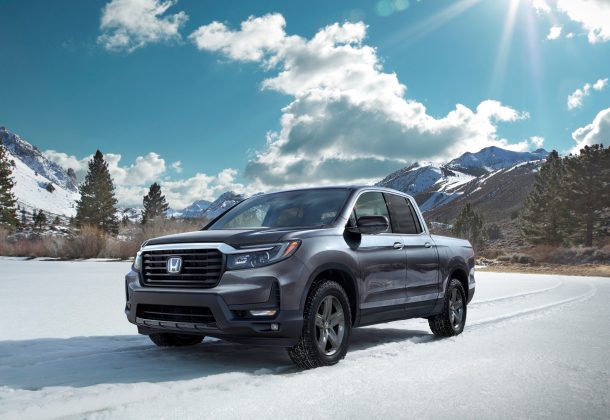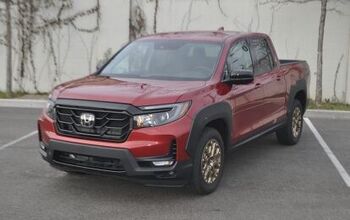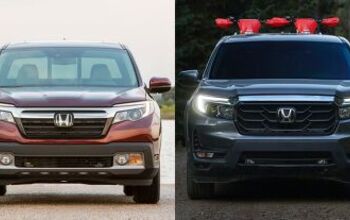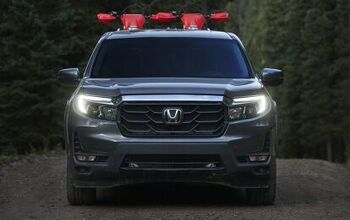2021 Honda Ridgeline: In Stores Now
The 2021 Honda Ridgeline arrives at dealerships today, with all-new sheetmetal upfront, a 280-horsepower, 3.5-liter V6, 9-speed automatic, and torque-vectoring all-wheel drive standard across the lineup. The manufacturer’s suggested retail price starts at $36,490, with a destination charge of $1,175.
As we described in an earlier post, the 2021 Ridgeline benefits from a redesign that speaks to its capabilities. The Ridgeline is said to have the segment’s largest interior for passengers and gear, featuring a flat floor and foldaway 60/40-split rear seat bottoms. Ridgelines have a versatile bed with a class-exclusive, in-bed lockable storage compartment, and standard AWD model payload capacity.
All Ridgelines feature 18-inch wheels and an additional 20 mm of track width to provide a stance more in keeping with that of a truck. New all-terrain tires with a more aggressive sidewall and shoulder design aid performance as well as appearance. Speaking of appearance, a new Radiant Red Metallic has been added to its exterior color palette.
Four post-production option packages available on all Ridgeline trims include Function – $270, Function Plus – $1,315, Utility – $1,465, and a new HPD package – $2,800. Developed in collaboration with Honda’s racing arm, Honda Performance Development (HPD), the package includes a distinctive grille treatment, HPD emblem, fender flares, bronze-colored wheels, and bedside HPD graphics.
Honda’s torque-vectoring all-wheel drive is now standard across the Ridgeline lineup. Up to 70 percent of the engine’s 262 lb-ft of torque is sent to the rear wheels, and it continuously allocates 100 percent of that torque between the left and right rear wheels based on driving conditions. Ridgeline’s standard AWD system further optimizes power delivery and distribution in various conditions, including snow, pavement, mud, and sand. Wringing out a Ridgeline test vehicle may be more fun than we imagined.
[Images: Honda]
With a father who owned a dealership, I literally grew up in the business. After college, I worked for GM, Nissan and Mazda, writing articles for automotive enthusiast magazines as a side gig. I discovered you could make a living selling ad space at Four Wheeler magazine, before I moved on to selling TV for the National Hot Rod Association. After that, I started Roadhouse, a marketing, advertising and PR firm dedicated to the automotive, outdoor/apparel, and entertainment industries. Through the years, I continued writing, shooting, and editing. It keep things interesting.
More by Jason R. Sakurai
Latest Car Reviews
Read moreLatest Product Reviews
Read moreRecent Comments
- Alan As the established auto manufacturers become better at producing EVs I think Tesla will lay off more workers.In 2019 Tesla held 81% of the US EV market. 2023 it has dwindled to 54% of the US market. If this trend continues Tesla will definitely downsize more.There is one thing that the established auto manufacturers do better than Tesla. That is generate new models. Tesla seems unable to refresh its lineup quick enough against competition. Sort of like why did Sears go broke? Sears was the mail order king, one would think it would of been easier to transition to online sales. Sears couldn't adapt to on line shopping competitively, so Amazon killed it.
- Alan I wonder if China has Great Wall condos?
- Alan This is one Toyota that I thought was attractive and stylish since I was a teenager. I don't like how the muffler is positioned.
- ToolGuy The only way this makes sense to me (still looking) is if it is tied to the realization that they have a capital issue (cash crunch) which is getting in the way of their plans.
- Jeff I do think this is a good thing. Teaching salespeople how to interact with the customer and teaching them some of the features and technical stuff of the vehicles is important.






































Comments
Join the conversation
So they make the track wider yet again, while I need the vehicle to become narrower in order to be considered for purchase. Thank you, Congress, for the CAFE formula! I suppose Americans voted for it, so there's no much to be said, except that the guys who protested at Capitol really peed it down their collective leg by not burning the place to the ground.
Hondas have had 7 year/ 100k mile timing belt change intervals since before I was born. I've never seen one break before then, even in competition use. Most of them are a 2-hour job plus $150 in parts and $20 worth of coolant, and in exchange the cam timing doesn't change as the chain wears out. The next-generation ICEs are going back to belts for efficiency and timing accuracy reasons. If I were drawing up a new engine today it would have one timing belt driving the cams, water pump, oil pump, and alternator. It would have a 13:1-14:1 compression ratio, direct injection with one upstream injector to get rid of carbon buildup and cool the turbo, and be headless to get rid of the head-block interface, with an aluminum block and the company's choice of surface treatment.